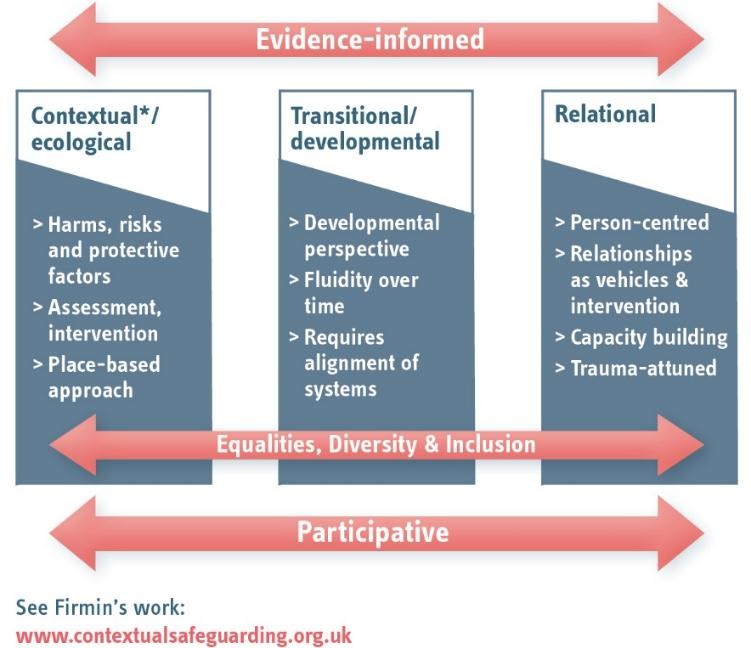As the concept of Transitional Safeguarding gains traction around the country, Research in Practice has been privileged to work with many local areas, supporting them to develop and shape local innovation.
We first coined the term Transitional Safeguarding in 2018 in our original briefing on the topic, carefully defining it as an approach to safeguarding adolescents and young adults in a way that's fluid across this developmental stage, and underpinned by clear evidence-informed principles. It means drawing on the very best of how we safeguard children and adults, and creating something fit for purpose for young people aged mid-teens to mid-20s.
Beyond protection – enabling young people to live safe fulfilling lives
Transitional Safeguarding means understanding an approach to safeguarding where we don't only protect young people, crucial though this is, but that we also enable them to live healthy, happy, safe fulfilling lives.
The need for a Transitional Safeguarding approach stems from the two very different safeguarding systems that operate for people aged under and over 18. These systems were designed before we understood what we now know about young people's development and the nature and interconnectedness of the harms they often face.
These two systems are not well connected, meaning that agencies are often working in silos, policy agendas are fragmented, and many young people are left without support when they turn 18. This abrupt withdrawal of support is often referred to as a cliff-edge. However, I am no longer using that term. Cliffs are a geological phenomenon, formed over millennia by forces outside of our control. That is not true of our current binary approach to safeguarding young people. A more accurate analogy would be a trench, not a cliff. We built the current arrangements – and it is within our gift to rebuild something better.
Transformation, not just training
It is important to emphasise Transitional Safeguarding is not a practice intervention, nor a standalone service to be delivered. There is no manual, and there is limited value in an individual agency trying to develop Transitional Safeguarding on their own. Understanding this is key to getting the right kind of support.
When organisations are considering the support that they might need, it’s tempting to see this as an issue of practitioner training. Continuing professional development (CPD) is an important part of any change process, but Transitional Safeguarding is not an intervention being delivered by practitioners alone. It's a concept for whole system change, underpinned by six key principles which must be embodied and embedded at all levels, from practice through to strategic leadership.
These six intersecting principles describe how a reimagined Transitional Safeguarding system must be:
- Evidence-informed in its approach.
- Contextual, or ecological, in its perspective.
- Transitional, or developmental, in its design.
- Relational in its ethos.
- Actively attentive to issues of equity, equality, diversity and inclusion.
- Participative in every aspect.
Six key principles of Transitional Safeguarding

The six key principles of Transitional Safeguarding
Since 2018, we've developed a wide range of resources and partnerships. We have worked with the Department of Health and Social Care, producing a briefing for those working in adult social work and safeguarding adults, and with HMI Probation to produce a paper exploring how Transitional Safeguarding relates to the justice sector.
We have worked with nursing roles, helping them to produce a knowledge briefing about Transitional Safeguarding specifically by and for health professionals. We have collaborated with colleagues at University of East Anglia, undertaking primary research commissioned by HMI Probation to explore how youth justice and probation colleagues understand and enact the key principles of Transitional Safeguarding. And most recently, I co-authored a book on Transitional Safeguarding with Professor Christine Cocker and Dr Adi Cooper.
Learning through practice
It is not only research and producing written resources that have helped us to learn. We have had the opportunity to work in a huge number of local areas across the country, supporting partnerships to develop their approach to Transitional Safeguarding. Through this we have learnt that it is essential to include perspectives from across all agencies, and to draw on practice expertise and the experiences of young people to develop local thinking about Transitional Safeguarding. This transformation cannot be ‘delivered top down’.
That said, it is also true that Transitional Safeguarding relies upon clear, credible, boundary-spanning leadership. Leaders across agencies need to collectively own, model and enable Transitional Safeguarding for it to become a reality. The revolution will not be deputised...
To state the obvious, different local areas work in distinct contexts and have different needs. What works best for colleagues and communities in Wandsworth will differ from Wiltshire, Wigan, or Weymouth. And that's exactly as it should be. Local innovation is best designed locally, by those who know the place and the people. Our role in supporting local areas to develop Transitional Safeguarding is not to prescribe, but to support organisations in identifying what they need and what strengths they have to build upon to enact the key principles of Transitional Safeguarding.
Embracing complexity and change
Undertaking system change of this nature is not simple or easy. It means getting comfortable with complexity. Something we always reinforce with the local areas we are supporting – innovation is not linear.
Our colleagues at University of Sussex reviewed innovation frameworks and they described this falsely reassuring linear presentation, as if change happens in a step-by-step process. It doesn't, of course, especially not this kind of complex system change. We always advise local areas to try and unlearn some habits that have become common in trying to manage change (transactional task and finish groups; RAG-rated action plans; Gantt charts and ‘sheep-dip’ training all spring to mind!). Some of those neat and linear approaches are unlikely to be effective for complex systems change, as they rarely take account of the social and cultural aspects of whole system transformation.
When we are working with local areas, we emphasise you're not building a flatpack shed. You can't simply follow someone else's instructions and build something with straight lines and right angles. Rather, you're growing a garden. It's messy and organic and emergent. You're going to have to break a sweat sometimes and get your hands dirty. Some things will thrive beyond your wildest dreams. Others simply will not be able to grow with the soil conditions as they are now.
So, part of our work in longer term reflective development programmes is often to help people hold the uncertainty. Don't be disheartened by delays or detours or experimentation or even failure, that's all part of the process.
Wherever you are, we are here to support
Wherever you are on your local journey and whatever kind of help you need – know that we are here to support you, as a critical friend and a champion of your work.
Developing Transitional Safeguarding requires collaboration across multi-agency partnerships to redesign a local offer for young people making the journey to adulthood. Whether it's:
- Bespoke programmes, including workshops and facilitated sessions designed to enable leaders to understand key concepts in Transitional Safeguarding and understand barrier and enablers within the local systems.
- Learning and professional development support tailored to meet your workforce and organisational needs.
- Supporting focus groups and other qualitative research activities.
- Theory of Change workshops and other evaluation support to understand the aims and impact of Transitional Safeguarding approaches in your area.
Transformation is a team sport. We look forward to learning alongside you and cheerleading you every step of the way.




